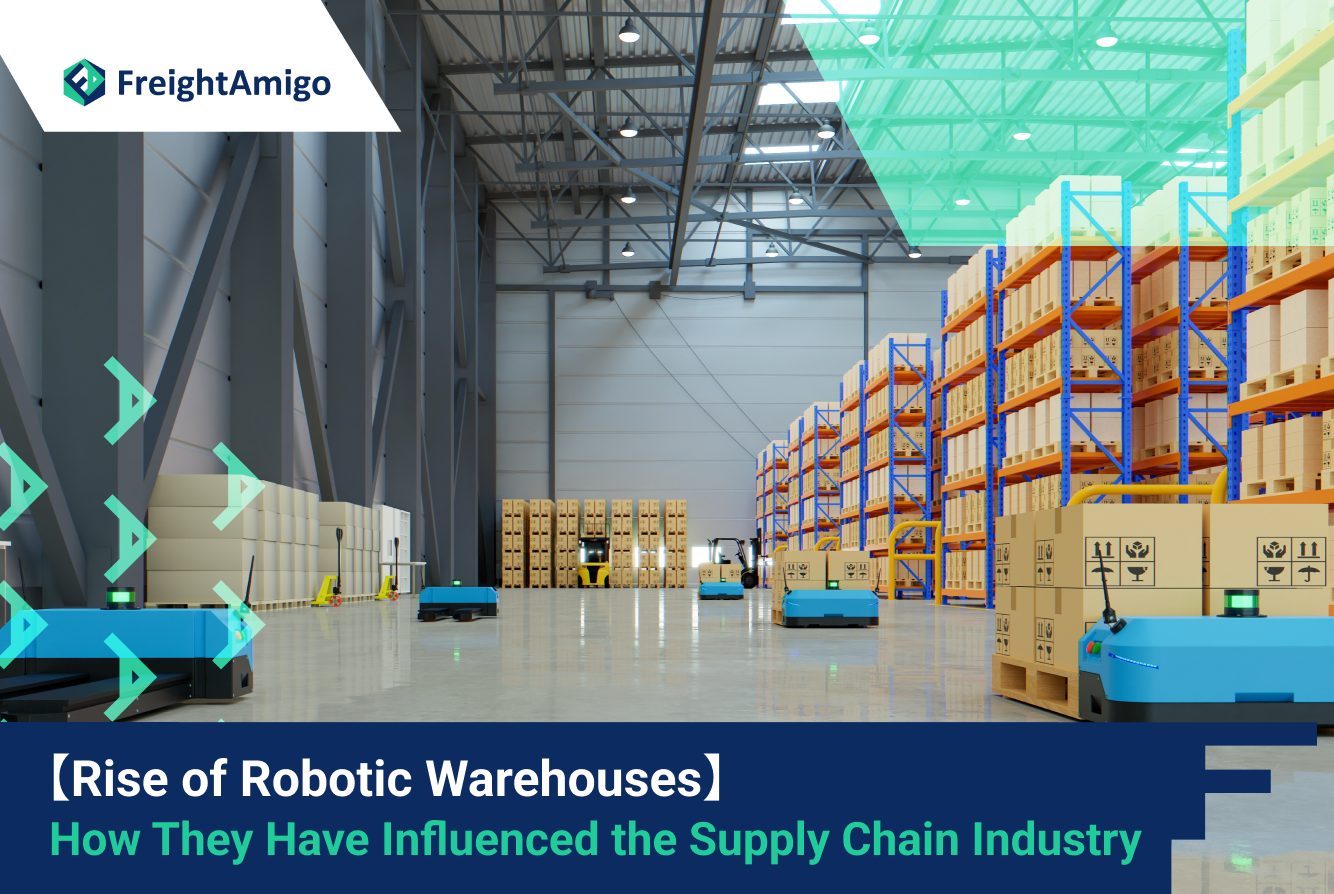In recent years, the supply chain industry has witnessed a revolutionary transformation with the rise of robotic warehouses. These cutting-edge facilities have become a game-changer, streamlining operations, increasing efficiency, and transforming the way products are stored and distributed. Robotic warehouses are a testament to the power of technology and automation in shaping the future of logistics.
One of the primary advantages of robotic warehouses is their ability to optimize space utilization. Traditional warehouses often struggle with limited capacity and inefficient layout designs. However, with robotic warehouses, every inch of space is utilized to its maximum potential. Robots, equipped with advanced algorithms and sensors, can navigate through narrow aisles and stack goods vertically, allowing for greater storage capacity.
Author Name:Tiffany Lee – Marketing Analyst at FreightAmigo
Want to compare the best Express, Air Freight, Sea Freight, Rail Freight & Trucking rates so as to have better control on cost?
Advantages of Robotic Warehouses
Robotic warehouses offer a multitude of advantages that can significantly improve the efficiency and productivity of supply chain operations. Firstly, these warehouses operate 24/7 without the need for breaks or rest, ensuring round-the-clock productivity. Unlike human workers, robots do not require sleep or rest intervals, thus eliminating any downtime and maximizing the utilization of resources.
Secondly, robotic warehouses greatly reduce the occurrence of errors in inventory management. With advanced scanning and tracking systems, robots can accurately identify, pick, and place items with precision. This minimizes the chances of misplaced or lost products, leading to improved accuracy in inventory counts and efficient order fulfillment.
Furthermore, robotic warehouses enhance workplace safety. By automating repetitive and physically demanding tasks, robots reduce the risk of accidents and injuries. Human workers can be assigned more strategic and value-added roles, ensuring a safer work environment.
How Robotic Warehouses Work
At the heart of a robotic warehouse is a complex network of robots, sensors, and control systems working in harmony to ensure seamless operations. The process begins with inventory intake, where robots equipped with scanners and cameras capture detailed information about each product. This data is then fed into a centralized system that manages the warehouse’s inventory.
Once the inventory is logged, the robots use their algorithms to determine the most efficient route for picking and placing items. They navigate through the warehouse using sensors and avoid obstacles in real-time. With pinpoint accuracy, the robots retrieve the required items and deliver them to the designated packing or shipping areas.
Robotic warehouses also employ machine learning algorithms that continuously analyze data to optimize processes. These algorithms can identify patterns, make predictions, and suggest improvements to enhance efficiency and reduce operational costs. With each interaction, the robots become smarter and more adept at handling the intricacies of warehouse operations.
The Impact of Robotic Warehouses on the Supply Chain Industry
The advent of robotic warehouses has had a profound impact on the supply chain industry. One of the most significant benefits is the considerable reduction in operational costs. By automating various tasks, such as inventory management and order fulfillment, companies can minimize labor costs and increase overall efficiency. This translates into faster order processing, reduced lead times, and improved customer satisfaction.
Additionally, robotic warehouses enable companies to optimize their inventory levels. With accurate real-time tracking and data analysis, businesses can better forecast demand and adjust their stock accordingly. This leads to reduced inventory holding costs and eliminates the risk of overstocking or stockouts.
Furthermore, the implementation of robotic warehouses has allowed companies to expand their market reach. With faster order processing and efficient distribution, businesses can now cater to a broader customer base, even those located in remote areas. This has opened up new opportunities for growth and expansion in the supply chain industry.
Future Trends in Robotic Warehouses
As technology continues to advance, the future of robotic warehouses holds exciting possibilities. One emerging trend is the integration of artificial intelligence (AI) into warehouse operations. AI-powered robots can learn from past experiences, adapt to changing environments, and make real-time decisions. This enables them to handle complex tasks and collaborate with human workers more effectively.
Another trend is the use of autonomous mobile robots (AMRs) in warehouse operations. These robots are equipped with advanced sensors and navigation systems that allow them to move freely around the warehouse, avoiding obstacles and optimizing their routes. AMRs can work alongside human workers, assisting in picking, packing, and transporting items, further enhancing productivity and efficiency.
Moreover, the future of robotic warehouses includes the incorporation of robotics in last-mile delivery. With the rise of e-commerce and same-day delivery expectations, companies are exploring the use of drones and autonomous vehicles to deliver products directly to customers’ doorsteps. This would revolutionize the supply chain industry by reducing delivery times and costs.
The Role of Human Workers in Robotic Warehouses
While robotic warehouses bring unprecedented levels of automation, human workers still play a critical role in their operations. The introduction of robots does not necessarily mean the elimination of jobs but rather a shift in job roles. Human workers are essential in overseeing the robots, maintaining the equipment, and handling tasks that require human judgment and creativity.
In robotic warehouses, human workers can be upskilled to take on more strategic and complex roles. They can focus on quality control, process optimization, data analysis, and customer service. By leveraging their expertise, human workers can contribute to the continuous improvement of warehouse operations and overall business performance.
Considerations for Implementing a Robotic Warehouse
Implementing a robotic warehouse requires careful planning and consideration. Companies must assess their specific needs, evaluate the scalability of the system, and invest in the right technologies. It is crucial to select robots that are compatible with existing infrastructure and software systems. Additionally, adequate training and support must be provided to human workers to ensure a smooth transition and maximize the benefits of automation.
Companies must also consider the return on investment (ROI) when implementing a robotic warehouse. While the initial costs may be significant, the long-term benefits, such as increased productivity, reduced labor costs, and improved customer satisfaction, outweigh the initial investment. By conducting a thorough cost-benefit analysis, companies can make informed decisions and ensure the success of their robotic warehouse implementation.
In conclusion, the rise of robotic warehouses is revolutionizing the supply chain industry. With their ability to optimize space utilization, improve efficiency, and reduce operational costs, these warehouses have become a game-changer in the world of logistics. While robots take on repetitive and physically demanding tasks, human workers play a crucial role in overseeing operations and contributing their expertise. As technology continues to advance, the future of robotic warehouses holds even more exciting possibilities, with the integration of AI, the use of AMRs, and the incorporation of robotics in last-mile delivery. It is imperative for companies to carefully consider their needs and plan their implementation to reap the immense benefits of this transformative technology.
There are different options for cargo transportation. If you want to choose the most convenient and suitable solution, it is best to have the full support of logistics experts! If you are planning to ship goods overseas, please go to the FreightAmigo page for inquiries.
===
Read More:
Embracing Industry 4.0: The Pivotal Role in Shaping the Future of Factory Automation
Mastering Purchase Order Management: The Role of Supplier Relationship Management
===
If you have any inquiries on logistics/supply chain, feel free to contact FreightAmigo now:
Chat with us online OR
Phone : +852 28121686
WhatsApp: +852 27467829









































